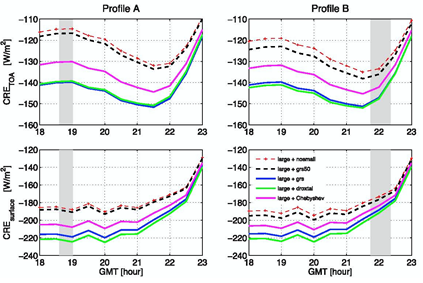The Influence of Observed Cirrus Microphysical Properties on Shortwave Radiation: A Case Study
Submitter
McFarquhar, Greg — University of Oklahoma
Nousiainen, Timo Petteri — University of Helsinki
Area of research
Radiation Processes
Journal Reference
Science
The shortwave radiative effect of an ice cloud observed over the Atmospheric Radiation Measurement Climate Research Facility’s Southern Great Plains site in Oklahoma during the 2000 Intensive Operations Period (IOP) was investigated using vertical profiles of the size and shape distributions of ice crystals constructed from airborne cloud microphysical probes, libraries of the single-scattering properties of idealized ice crystal shapes derived using state-of-art codes, and measured direct and diffuse radiative fluxes at the ground. Sensitivity studies quantified the distinct impact of uncertainties in the concentration and shape of small ice crystals on radiative fluxes, offering new insights into understanding the connection between particle morphology, cloud microphysics and cloud radiative effect. The sensitivity tests also determined if uncertainties in cloud properties derived from in situ probes could account for discrepancies in observed and modeled radiative fluxes, or if additional factors are needed to describe the differences.
Impact
In situ data from a Cloud Particle Imager, optical array probes, and a forward-scattering spectrometer were used to construct vertical profiles of the size and shape distributions of ice crystals. Due to uncertainties associated with measuring the sizes and shapes of small ice crystals with maximum dimensions less than 120 micrometers, five alternate size-shape distributions were derived and combined with existing databases of wavelength-dependent single-scattering properties of idealized ice crystals to obtain vertical profiles of optical properties, such as extinction, single-scattering albedo and asymmetry factor. The surface and the top-of-the-atmosphere fluxes were then computed for each realization with the libRadTran radiative transfer package. Comparison of the modeled surface fluxes against those measured at the surface showed the differences were too large to be explained by uncertainties in the shape and concentrations of small ice crystals. Additional sensitivity tests suggested that the discrepancies occurred because the real optical thickness, estimated from the cloud radar, was larger than that derived from the aircraft profiles most of the time. When the optical thickness was derived based on measured direct fluxes, the modeled total downward flux agreed better with the measurements. Reductions in the asymmetry parameter of less than 10%, possibly associated with the presence of surface roughness, air bubble inclusions, or other non-idealities in ice crystals, further improved agreement with observations.
Summary
Assumptions about cloud horizontal homogeneity and offsets between flight profiles and ground measurements could have contributed to the differences between simulated and observed fluxes being larger than those caused by uncertainties in the concentrations and shapes of small ice crystals. Good agreement was obtained when the direct radiation measurements were used to derive the optical depth. Therefore, in the future, vertical profiles of in situ aircraft measurements coincident with scanning radar data should be used to accurately assess the impact of shape and size uncertainties on three-dimensional cloud fields and on the corresponding single‐scattering properties, and consequently on radiative fluxes.


